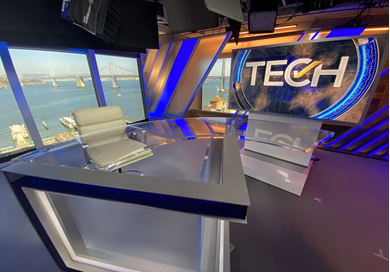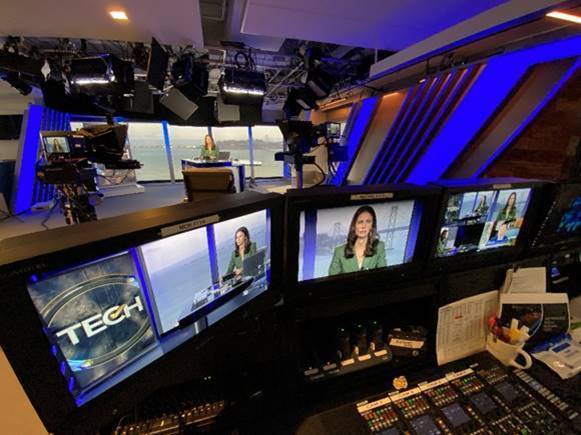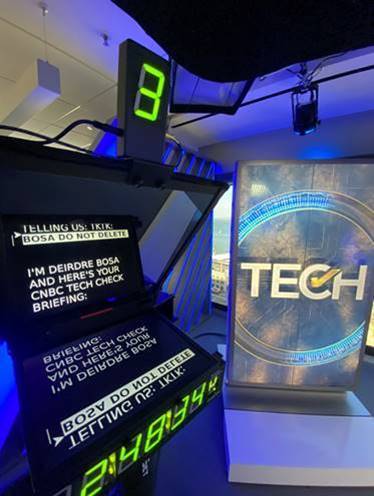CNBC’s New 1 Market Studio: It’s All About The Look And Low-Latency
The new studio’s quarter-second coast-to-coast latency makes news conversations natural

SAN FRANCISCO—CNBC’s new Steuart Tower studio in San Francisco may not be the biggest or most expensive studio revamp the network has ever taken on, but what it may lack in scale the 1 Market Studio makes up for in technical innovation, especially when it comes to minimizing latency, and appealing design.
“We launched a show a couple of months ago called ‘Tech Check,’ and being a tech show we felt we really had to have a real, legitimate presence out there [in San Francisco],” says Steve Fastook, senior vice president of operations and engineering at CNBC.
The business-news cable network chose to expand its existing San Francisco bureau, originally built about a decade ago, transforming a rather simple Flash Studio into an attractive space taking full advantage of its seventh-floor view of the Bay Bridge and an appealing set design by John Casey Production Design.
Lowering Latency
It’s the exception rather than the rule for a full production crew to run shows from 1 Market Studio. Rather, most of the network’s production assets and production control technology reside in Englewood Cliffs, N.J., at CNBC headquarters, says Fastook. So, reducing latency between the 1 Market Studio location and New Jersey was essential.
CNBC upgraded its bandwidth between the locations from 1Gb/s to 10Gb/s and installed Cisco IP video gateways supporting Hitless Merge and Evertz JPEG 2000 encoders and decoders. “We went from a roundtrip before we did the project of about a second and a half to now a roundtrip of a quarter of a second,” he says.
From a production point of view, the nearly non-existent latency brings a natural feel to the on-camera give and take between contributors. “[With] cross talks, you don’t even know they’re not in the same room. That’s huge for us because it’s natural conversation,” says Fastook. “What we wanted to be able to have was cross talks between anchors in New York, New Jersey and San Francisco.”

However, what happens on screen is only a part of the story. Off camera, the ultra-low latency means operators in Englewood Cliffs can control the three Vinten robotic heads supporting the new 4K-upgradeable Sony box cameras with Canon lenses at 1 Market Studio as if they were in the studio.
Get the TV Tech Newsletter
The professional video industry's #1 source for news, trends and product and tech information. Sign up below.
“That’s sort of the theme we’ve been taking. If you’re doing a show and it’s coming from a particular location, you grab the cameras at that location and you can control them like you are there,” he explains. “With the connectivity being so upgraded, that control is fluid.”
In a similar fashion, the low latency helps to enable CNBC to run audio remotely from Englewood Cliffs. CNBC installed Calrec audio boards and the Calrec RP1 remote-controlled processing engine.
“If you acquire a microphone in Englewood Cliffs that’s out in the studio, it’s the same as acquiring a microphone in San Francisco. All of the mix-minus and everything else can be assigned and followed,” says Fastook, who notes the approach made it unnecessary to add another audio operator.
“Everything comes back homerun through this RP1. You could look at your board and see four inputs from the studio mics in New Jersey, two from the stock exchange, two from the NASDAQ and three from San Francisco, and it really makes no difference. That really enabled three- and four-party conversations to really be as real as possible.”
The new studio’s lighting system, like the lighting systems in all CNBC remote locations, is controllable from Englewood Cliffs. Fastook relied on CNBC ENG crew members to design and install the setup, which consists of LED fixtures, including Rosco studio lighting and large Litepanels LED studio lights.
Using LED fixtures was important because Steuart Tower is an office building. “Our ceiling height is a little bit higher than normal office space, but there’s no great height, and the air conditioning is really designed for office space, so the LED lighting was critical,” says Fastook.
While remote operation is integral to the 1 Market Studio workflow, local robotic camera, lighting and audio control are also available when needed, he adds.

The redesigned space also relies on an electronic shade system on every window. Used throughout the day and prominently featured during “TechCheck,” which premiered in April, the space is subjected to the sun as it traverses the sky.
“The sun comes up in the corner of the building, and it sets on the other side of the building,” says Fastook, “and we’re on through the whole horizon of the day.”
Working with Broadcast Blinds, CNBC installed electronic shades on every window—whether they’re fully behind scenery or partially blocked by scenery. As the sun moves, the ND filters used as shades can be dialed in and out depending on the time of day.
COVID And The Studio
Like so many other things in broadcasting and society at large, expanding 1 Market Studio was not immune to the effects of the COVID-19 pandemic. In the case of the studio, however, its impact was both positive and negative.
Typically renovating the small bureau to a 2,500-square-foot remote studio complete with a custom set would have required Fastook and crew to restrict their work to overnights and long weekends, making sure the space was ready to use when the broadcast schedule resumed every day. That start-and-stop approach would have required two months to complete this studio upgrade. However, COVID changed the equation, he says.
“Because of COVID, the bureau had been closed. We were able to go in and do everything we needed to do, and the whole project was completed in over a little less than three weeks, including the set, which took at least a week,” he says.
However, the new studio was not exempt from supply chain problems—particularly chip shortages—that are plaguing the economy during this stage of the pandemic. While Fastook made his completion deadline for the project, the job was “pushed to the limit,” he says.
“It really was a little bit less about the broadcast equipment, and a little a little bit more about the traditional switch gear—mostly Cisco-type stuff—that really got hit by the chip shortage,” says Fastook, who attributes getting the job done on time to being in the queue for equipment “pretty early in the process,” ensuring a place near the front of the line when the crunch began to ease.
Engineering for the studio renovation, which Fastook estimates cost between $150,000 and $200,000, was done by CNBC engineers, and the actual work was completed by an implementation team from NBCU.
While production from the renovated space supports CNBC’s 1080i HD needs today, the three Sony box cameras selected for the studio are 4K-capable, preparing 1 Market Studio for the future.
“We’re getting to the point where the amortization of those cameras may fall into our 4K transition—although I don’t know what that is, we haven’t really decided,” says Fastook. “It’s really more driven by the desire for it to be 4K than the content. This isn’t sports—that’s a whole different thing.”
But as the rest of world adopts 4K, there will come a point where transitioning to 4K may be unavoidable. When that day comes, 1 Market Studio will be ready.
Phil Kurz is a contributing editor to TV Tech. He has written about TV and video technology for more than 30 years and served as editor of three leading industry magazines. He earned a Bachelor of Journalism and a Master’s Degree in Journalism from the University of Missouri-Columbia School of Journalism.

